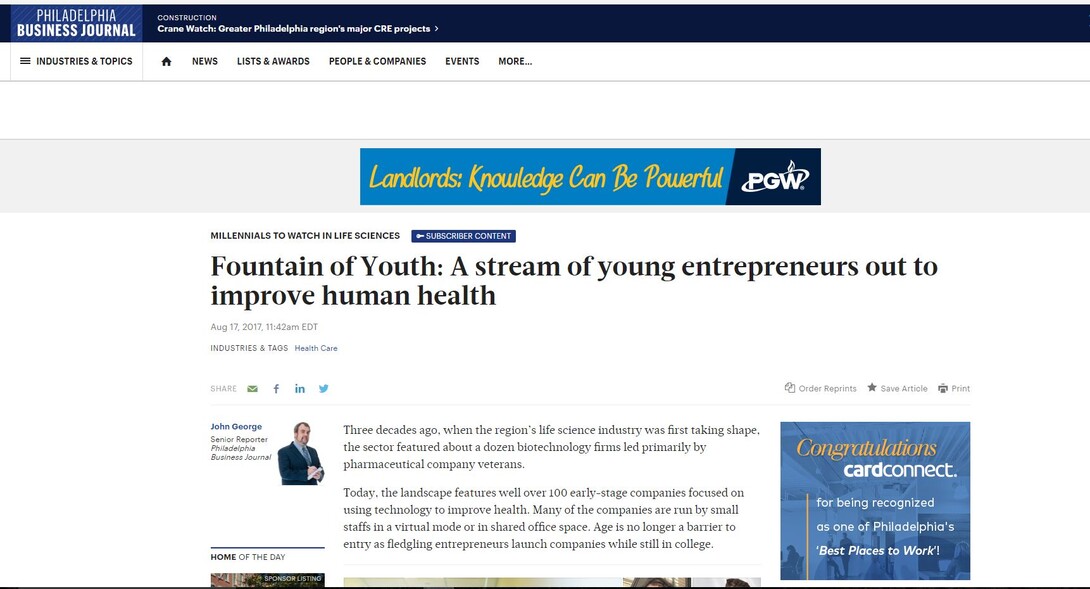Millennials to Watch in Life Sciences
Fountain of Youth: A stream of young entrepreneurs out to improve human health
Three decades ago, when the region’s life science industry was first taking shape, the sector featured about a dozen biotechnology firms led primarily by pharmaceutical company veterans.
Today, the landscape features well over 100 early-stage companies focused on using technology to improve health. Many of the companies are run by small staffs in a virtual mode or in shared office space. Age is no longer a barrier to entry as fledgling entrepreneurs launch companies while still in college.
In this report, we put the spotlight on a dozen Millennials to Watch in the life sciences field. They are involved in developing innovations ranging from new cancer therapies to a “circadian-friendly” nightlight to improve sleep. One of the questions we asked them is what unique challenges their generation of entrepreneurs faces. Three themes emerged:
Cooperation is valued; impatience must be controlled
“We have the most incredible technologies and analytical systems available that can solve nearly any problem,” said Dr. David Fajgenbaum, a 32-year-old assistant professor of genetics at the University of Pennsylvania, who is the executive director of the Castleman Disease Collaborative Network. “The greatest challenge is for us to work together to harness this opportunity to make progress as quickly as possible. Patients are waiting.”
Lorenzo Albala, 25, a Thomas Jefferson University medical student, said he believes his “well-connected generation” is inundated by the success of others. “Sometimes,” Albala said, “we balk at the long, hard road to success, when really we need to take the time to nurture our own selves.”
Margaret Prendergast, 24, a bioengineer at BioBots, said advancements in technology connect people like never before. “The most exciting innovations come from multidisciplinary work inspired by these connections,” she said. “To develop these ideas, life science entrepreneurs are challenged to create diverse teams and understand topics outside their area of expertise.”
It’s tough to keep up with the pace of technology advancements
“Our innovations are moving faster than the regulatory bodies and manufacturing industries,” said 32-year-old Bethany Edwards, co-founder and CEO of LIA Diagnostics. “This makes commercialization and scaling even more challenging. It means we are often having to devote substantial time and resources to rewriting the rules of other industries or flat-out creating our own in-house processes and manufacturing in order to commercialize our innovations faster.”
Dr. Daniel Wasser, the 31-year-old president of Photon Biomedical, said the life sciences industry and medicine in general are becoming increasingly technical. “A major challenge is finding ways to leverage innovations, such as augmented reality or electronic medical records, to deliver improved clinical outcomes,” he said.
Michael Whitley, 27, co-founder and COO of Precision Nano, agreed the rate at which new technologies are emerging and being developed is a big challenge for millennials. “It makes it difficult to grasp the pulse of the field,” he said. “The way that CRISPR (a genetic engineering technique) has moved from the lab to clinical development is good evidence of that.”
Funding can be a problem for entrepreneurs of all ages
“When I think of unique challenges for millennials in life sciences I think of the challenge of finding product/market/fit,” said Nick Delmonico, CEO and co-founder of Strados Labs. “Without deep ties into existing life sciences communities, patient advocacy groups, or research institutions, you can lose momentum trying to build and form relationships with the right people to test your ideas and products … Life sciences demands a lot of capital as well as the right testing ground to truly execute the right solution.”
Delmonico added that life cycle for product development in life sciences is much longer and capital intensive than other industries, which is a challenge for everybody. His company is planning to launch a crowdfunding platform on Kickstarter this fall for its breath and activity tracker that uses acoustic lung sound technology.
Varun Vijay Prabhu, 30, associate director for research and development for Oncoceutics Inc., said the uncertainty over National Institutes of Health funding makes developing technological advances a challenge. “While we have the tools and knowledge to make rapid strides in biomedicine, lack of funding is driving away talented scientists,” he said.
Edwards believes expectations from investors on people like herself are increasingly becoming more demanding. “While this is fine — entrepreneurs don’t typically mind challenges — the market,” she said, “we’ll need to equally recognize and reward the added pressures, absorbed risks, and additional value created by this generation’s entrepreneurs.”
...
Margaret Prendergast
- Age: 24
- Hometown: Jamison
- Now lives in: Center City
- Education: Bachelor’s degree in bioengineering from the University of Maryland
Prendergast is bioengineer at BioBots, the developer of a desktop three-dimensial printer for living cells.
Why did you choose a career in life sciences?
I was motivated by the chance to utilize engineering and biology to improve public health.
What are the advantages and disadvantages of starting or working at a life sciences company in the Philadelphia region? Philly may not have the reputation of Silicon Valley, but it has a strong community and a growing scene of entrepreneurship. Check out Life Sciences PA and Pennovation. The impressive network of hospitals and universities are also a great resource. Plus, the cheesesteaks are delicious.
...
